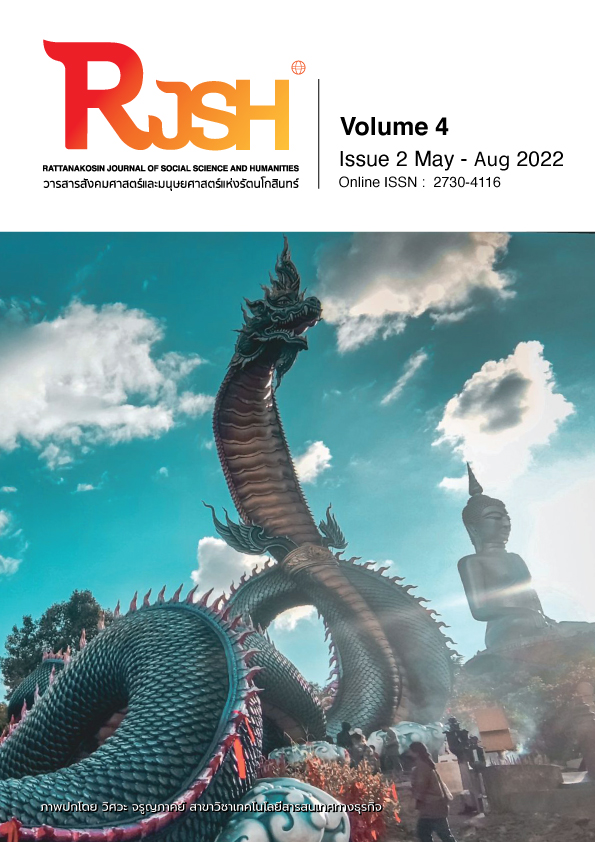The Logistics and Supply Chain Management of Herbal for Community Enterprise: Case Study of Don Tum District, Nakhon Pathom Province
Main Article Content
Abstract
The purpose of this study is to measure the efficiency of the logistics and supply chain management of herbal goods in Don Tum, Nakhon Pathom community enterprise. A questionnaire was used to gather the data. The data were analyzed by measuring efficiency using a model based on a supply chain operation. The result of the study shows that the average purchase of raw materials is 5 days at a time on the planning side. The average amount of raw materials in the stockpile is 15,250 kilograms, and the lead time for purchasing is 4 days per time. For the production side, the processing period is 10 kilograms per hour and the production capacity is 6,300 kilograms per month. For the logistics side, it has been discovered that the delivery time after placing an order is 5 days per order, with a delivery fee of 20 baht per kilogram, and a return rate of 8.30 percent. The result of the study suggests that the community research group should develop operational models. Encouraging the production and processing of herbs into more efficient products will increase income generation and is widely accepted by both domestic and foreign consumers.
Article Details
The content within the published articles, including images and tables, is copyrighted by Rajamangala University of Technology Rattanakosin. Any use of the article's content, text, ideas, images, or tables for commercial purposes in various formats requires permission from the journal's editorial board.
Rajamangala University of Technology Rattanakosin permits the use and dissemination of article files under the condition that proper attribution to the journal is provided and the content is not used for commercial purposes.
The opinions and views expressed in the articles are solely those of the respective authors and are not associated with Rajamangala University of Technology Rattanakosin or other faculty members in the university. The authors bear full responsibility for the content of their articles, including any errors, and are responsible for the content and editorial review. The editorial board is not responsible for the content or views expressed in the articles.
References
กรุงเทพธุรกิจ. (2563). ตลาดสมุนไพร เศรษฐกิจหลักของไทย. สืบค้นเมื่อ 8 มกราคม 2564 จากhttps://www.bangkokbiznews.com/news/detail/914569.
กฤษณ์ชาคริส ณ วัฒนประเสริฐ. (2559). การประยุกต์การจัดการโลจิสติกส์และโซ่อุปทานในงานอุตสาหกรรม. พิมพ์ครั้งที่ 1 กรุงเทพฯ: สำนักพิมพ์ปัญญาชน.
กองส่งเสริมวิสาหกิจชุมชน กรมส่งเสริมการเกษตร. (2563). รายชื่อวิสาหกิจชุมชน/เครือข่ายวิสาหกิจชุมชน. สืบค้นเมื่อ 5 สิงหาคม 2563 จาก http://smce.doae.go.th/Product Category/SmceCategory.php? page_size=10&PAGE=1&province_id=73®ion_id=&hur_id=04&key_word=&startPage=1&endPage=3
เกษตรก้าวไกล. (2562). พืชเศรษฐกิจ. สมุนไพรขึ้นแท่นตลาดระดับโลกส่งออกแสนล้าน เกษตรฯ เร่งยกระดับมาตรฐาน. สืบค้นเมื่อ 10 กรกฎาคม 2563 จากhttps://www.kasetkaoklai.com/home/2019/07/สมุนไพรผงานดขึ้นแท่นตลา/.
จีรวรรณ ทองยืน. (2560). การวิเคราะห์แนวทางเพื่อเพิ่มมูลค่าให้กับอุตสาหกรรมยาจากสมุนไพรไทย. วิทยานิพนธ์บริหารธุรกิจมหาบัณฑิต, มหาวิทยาลัยธรรมศาสตร์.
ไทยวินเนอร์. (2563). โลจิสติกส์และโซ่อุปทาน ต่างกันอย่างไร?. สืบค้นเมื่อ 16 กรกฎาคม 2563 จาก https://thaiwinner.com/logistics-supply-chain/.
สันติ ศรีสวนแตง, ประสงค์ ตันพิชัย และทิพวัลย์ สีจันทร์. (2563). สถานการณ์ ศักยภาพ และแนวทางในการจัดการสุขภาพชุมชนเพื่อเศรษฐกิจฐานราก : กรณีศึกษาสมุนไพรพื้นที่ลุ่มแม่น้ำนครชัยศรี จังหวัดนครปฐม. วารสารการแพทย์แผนไทยและการแพทย์ทางเลือก, 18(2), 406-419.
Andarini, D. & Adhiutama, A. (2013). Supply Chain Performance Measurement: The Case of a State-Owned Pharmaceuticals Company (BFM). Global Journal of Business and Social Science Review. 1(1), 33-49.
Booker, A., Johnston, D., & Heinrich, M. (2012). Value chains of herbal medicines-Research needs and key challenges in the context of ethnopharmacology. Journal of ethnopharmacology, 140(3), 624-633.
Supply Chain Council. (2011). What is SCOR?. Retrieved on August 31, 2020, from http://supplychain.org/scor.


